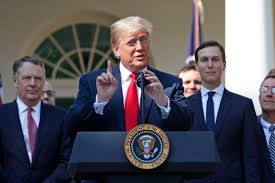24 Jan 2025 Indian Express Editorial
What to Read in The Hindu Editorial( Topic and Syllabus wise)
Editorial 1 : A Weaker Shield
Context: Trump withdrawing from WHO: Clipping its wings could hurt not just poor and middle-income countries, but also the US
Introduction: Donald Trump’s decision to sever his country’s links with the WHO wasn’t unexpected. While this move aligns with Trump's longstanding criticisms of the UN body, it raises concerns about its impact on global health security and the US itself.
Trump’s Actions Against WHO
- Defunding the WHO
- Directed US agencies to halt the transfer of funds or resources to the WHO.
- Instructed the identification of alternative partners to undertake activities previously handled by WHO.
- Halting Participation in WHO Treaties
- Ordered the US secretary of state to cease negotiations on the WHO Pandemic Agreement.
- Severed ties with treaties, including the International Health Regulations, vital for epidemic preparedness and response.
WHO’s Global Role and Importance
- Global Health Emergency Response
- WHO is the only global body with the legitimacy and reach to address infectious diseases and cross-border outbreaks.
- Played a crucial role in creating protocols to mitigate the spread of diseases like Covid-19.
- Non-Communicable Disease Prevention: Provides expertise to combat diseases such as cancer, which have a significant global burden.
- Collaboration: The WHO facilitates partnerships among public health agencies, laboratories, and scientists to track and control novel outbreaks.
Historical Relationship Between the US and WHO
- Founding Member and Financial Contributor: The US is one of the WHO’s founding members and historically its largest financial supporter.
- US-Soviet Collaboration During the Cold War: WHO served as a neutral platform for collaboration, contributing to the eradication of smallpox.
- Dependence of US Agencies and Pharma Industry
- US institutions like the Centre for Disease Control and Prevention (CDC) and National Institute of Health rely on WHO’s networks for disease tracking.
- Over 20 WHO collaborating centres in the US focus on national priorities like cancer prevention and global health security.
Criticism of Trump’s Decision
- Impact on Global Health Security
- Defunding the WHO and halting treaty participation weakens the global health security architecture.
- The WHO Pandemic Agreement is vital for preparedness against future outbreaks.
- Risks to US Interests
- Undermines the US’s ability to respond to health emergencies by limiting access to WHO’s network and expertise.
- Could compromise resilience against emerging health threats.
Way Forward and Conclusion
- The WHO needs reform. But deficiencies in its governance and funding structures highlighted by the Covid pandemic need to be addressed by engaging the agency, not remaining outside it.
- The pandemic showed that no country is immune to the caprices of pathogens.
- Clipping the WHO’s wings could hurt the resilience of not just poor and middle-income countries.
It could also compromise the US’s preparedness against a health emergency.
Editorial 2 : The New Trade
Context: India’s trade relationship with Trump 2.0: India must leave no stone unturned.
Introduction: The second Trump presidency has caused a considerable anxiety across the world over what the US president would do on tariffs.
US Tariff Policies and Current Uncertainty
- Trump's Focus on Tariffs
- Trump has repeatedly spoken about imposing tariffs on countries such as Mexico, Canada and China.
- He has attacked India’s tariff structure, pointing specifically at the 100% rate levied on some products.
- Lack of Immediate Policy Action
- Days after inauguration, no concrete steps have been taken.
- Reports suggest tariffs on some countries might be imposed starting February 1, leading to uncertainty.
India-US Trade Relations
- Significance of Bilateral Trade
- In 2023-24, bilateral trade between India and the US was approximately $120 billion.
- Both countries share a consensus on strengthening relations despite tariff concerns.
- Recent Cooperation: Memorandum of Understanding (MoU) signed in October to diversify the critical minerals supply chain.
- Preparatory Measures by India: Commerce ministry holding inter-ministerial discussions to address potential US trade policy changes.
Opportunities in Trump’s Trade Policy
- Focus on Bilateral Agreements
- America First trade policy emphasizes bilateral or sector-specific agreements to secure market access.
- Potential for India to explore a bilateral trade agreement with the US.
- Past Negotiations: India and the US had discussed a trade deal during Trump’s first term, signalling a potential for renewed talks.
Challenges in Trade Negotiations
- Labour Mobility: Trade deals may be linked to labour mobility, a sensitive and complex issue requiring careful handling.
- Other Areas of Concern
- Intellectual property rights.
- Labour markets and government procurement.
- Data localization policies.
- Tariff Reduction: Any agreement will likely require India to reduce tariffs, necessitating a broader evaluation of its tariff structure.
India’s Mixed Approach to Trade Agreements
- Recent Trade Pacts: Entered agreements with the UAE and Australia.
- Missed Opportunities
- Shied away from the Regional Comprehensive Economic Partnership (RCEP).
- Did not join the trade pillar of the Indo-Pacific Economic Framework.
- Ongoing Negotiations: EU and UK trade agreements have been under negotiation for a prolonged period.
Way Forward: Recommendations for India
- Comprehensive Trade Policy Review
- Broaden the examination of India’s tariff structure.
- Resist protectionism to enhance competitiveness.
- Leverage Global Opportunities: Implement much-needed reforms to capitalize on the changing global trade environment.
- Prioritize Trade Agreements
- Push forward negotiations with the EU and UK.
- Explore a bilateral trade agreement with the US while addressing areas of concern.
- Utilize the Union Budget: Use the upcoming Union budget to introduce steps towards tariff reforms and trade liberalization.
Conclusion
Donald Trump’s tariff rhetoric poses challenges and offers opportunities for India to strengthen economic ties with the US. By addressing concerns around trade agreements, reducing tariffs, and implementing structural reforms, India can position itself to benefit from the evolving global trade landscape.


